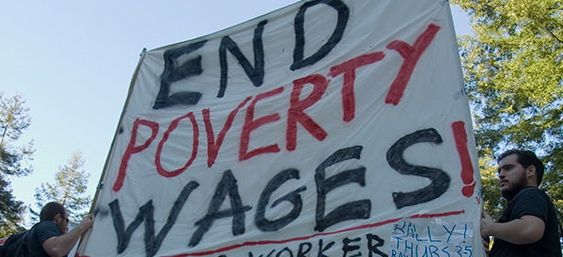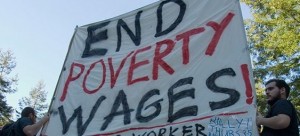
The wages of poverty
MIAMI – This week brought some good news for working people – for a change. California, the biggest state in the nation by population is on the verge of increasing the minimum wage to $9 an hour next year and $10 in 2016.

The Huffington Post makes two points to argue “that this is a big deal.” First, a recent study found that had the minimum wage in 2011 been $10.10 an hour, 58 percent of the working poor would have risen above the poverty line. Second, California has the greatest number of working poor in the nation so an increase in the minimum wage will improve the lives of lots of people.
By all means, let’s pause to celebrate this rare victory. As Rosa Luxembourg is supposed to have said, “If I can’t dance, I don’t want to be in your revolution.” Or, as the late Saul Alinsky, the renowned community organizer and a favorite whipping boy of the right-wing, taught, a movement, like the one for a $15 an hour minimum wage by waged by Walmart employees, needs small victories to celebrate in order to sustain itself and grow.
At the same time, no movement can endure for long on illusion or without a clear understanding of historical context. The federal minimum wage was established in 1938, one of many progressive measures enacted under FDR’s New Deal. It was intended to ensure that anybody who works can earn at least enough to pay for the necessities of life. The initial hourly minimum wage was set at $1.60. That’s the equivalent of $10.56 an hour in 2013 dollars. That means that, taking into account inflation between now and 2016 (the new California minimum wage is not indexed for the cost of living), the state with the highest minimum wage in the country will boast a minimum wage significantly below the 1938 national level! While the wealth of the country has increased many-fold since the Great Depression, the purchasing power of low-paid workers, even those who live in relatively progressive states like California, has actually declined.
Nevertheless, in California, Republicans are crying bloody murder over the new minimum wage calling it a “job killer.” Their predecessors did the same back in the 1930s, predicting economic doomsday. Nothing of the sort happened; the economy boomed from the late 1940s to the late 1960s while the value of the federal minimum wage, in constant dollars, rose modestly but steadily. Thus the evidence is clear that increases in the real minimum wage do not depress economic growth. If anything, the opposite is true.
Since the late 1960s, the real value of the federal minimum wage has decreased dramatically (as has the rate of economic growth). So much ground has been lost that even a substantial increase like California’s falls short. Proposed increases in the federal minimum wage to bring it more in line with changes in the cost of living repeatedly have been foiled mainly by Republican opposition in Congress and/or the White House. That is what has prompted the fight for a living wage in cities and states across the nation, with varying degrees of success.
Not only is the stated basis of Republican opposition to increases in the minimum wage unsupported by the facts. The people don’t support them on this either, even many Republicans. Florida provides a good test of this proposition. In the 2004 general election the state went for George W. Bush (for real this time) by a modest margin. But there was nothing modest about the victory of the ballot initiative calling for an increase in the minimum wage indexed to the cost of living. Over 71 percent of voters approved the change, a landslide by any measure. Thus a popular vote accomplished what the Republican-controlled state government would never have agreed to.
Despite this popular victory, the minimum wage in Florida today – $7.79 an hour – is inadequate. In a best case scenario, with no periods of unemployment or part-time work, a person employed 40 hours a week working 52 weeks would earn $16,203 a year. What single mother with children could get by on that?
The working poor have been taking the worst beating of anybody in the new American economy but they are not alone. Florida again provides a case in point. According to a recent study, median hourly wages in the state decreased by 4.3 percent between 2000 and 2011. In 2000, the median hourly wage in 2010 dollars was $14.50 but by 2011 it had dropped below $14. There are also wide racial/ethnic disparities in earnings. Blacks were three times as likely to earn less than whites than the reverse, Hispanics twice as likely.
The news from California is encouraging. So is the enormous popular support for raising the minimum wage to a realistic level – as shown in the lopsided victory of the pro-increase forces in the relatively conservative state of Florida in 2004. But the obstacles are formidable. With so many people unemployed, working part-time not out of choice, or so discouraged they have left the labor force altogether, right now it’s a buyer’s market when it comes to labor. This makes it easy for employers to keep wages low and pocket virtually all the gains in productivity in the form of profit. And corporations and their allies in government for more than two decades have been waging a savage and largely successful campaign to destroy the main weapon workers have (or used to have) to fight back, labor unions.
It is going to be, at best, a long uphill struggle. But it is one we must wage, not just out of outrage at the plight of the poor but also and ultimately, out of self-interest – to save our own skins.
Click here to also read Yadira Escobar’s “Can’t live on this minimum wage.”

